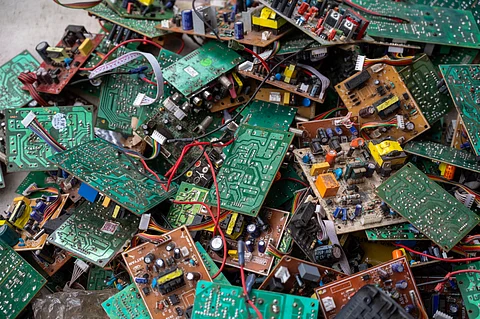

India witnessed a surge in electronic waste (e-waste) generation over the past five years, rising from 1.01 million metric tonnes (MT) in 2019-20 to 1.751 million MT in 2023-24, according to data presented by Minister of State for Union Ministry of Housing and Urban Affairs Tokhan Sahu in the Rajya Sabha on December 16, 2024.
The national-level figures reveal a concerning 72.54 per cent increase in e-waste generation since 2019-20, reflecting the growing use of electronic and electrical devices across the country. The minister provided this data in response to a question about the amount of e-waste generated in urban areas over the last five years.
Interestingly, the sharpest rise in e-waste generation was observed between 2019-20 and 2020-21, a period when electronic consumption increased due to the demand for work-from-home and remote learning arrangements during the COVID-19 pandemic.
E-waste contains hazardous materials which, if not properly handled and treated, can have damaging effects on the environment and human health. These toxic materials include heavy metals and substances such as arsenic, cadmium, lead, and mercury, as well as persistent organic pollutants.
Responding to the query about state-wise e-waste generation over the last five years, the minister clarified that such data is unavailable. Instead, e-waste generation is estimated nationally based on sales data provided by producers and the average lifespan of electrical and electronic equipment (EEE) items.
Data for the expanded list of 106 EEE items will only be available starting FY 2023-24. For the previous years (2019-2023), the national-level figures reflect e-waste generated from 21 EEE items under the E-Waste (Management) Rules, 2016, the Parliament was told.
The minister emphasised the government’s efforts to address this challenge under the E-Waste (Management) Rules, 2022, which became effective on April 1, 2023. The updated rules aim to streamline e-waste collection and recycling by holding producers accountable through Extended Producer Responsibility (EPR) and requiring proper disposal through authorised recyclers.
Under EPR, producers of EEE, as specified in Schedule I, are assigned annual recycling targets based on the quantity of e-waste generated or products sold. To meet these targets, producers are required to purchase EPR certificates from registered recyclers. These certificates are issued by recyclers based on the quantity of recycled products sold in the market.
Additionally, public institutions, including schools and government offices in urban areas, are categorised as bulk consumers under the E-Waste (Management) Rules, 2022. According to Rule 9, bulk consumers of EEE listed in Schedule I must ensure that the e-waste they generate is handed over solely to registered producers, refurbishers, or recyclers, Sahu told the Parliament.
In August 2024, government data presented in the Rajya Sabha revealed a significant increase in the share of e-waste recycled over the past five years. The proportion of e-waste processed rose from 22 per cent in 2019-20 to 43 per cent in 2023-24. Despite this progress, approximately 57 per cent of e-waste— equivalent to 990,000 metric tonnes — remains unprocessed in the country.
“The recycling rate for e-waste remains low due to the authorities’ inability to effectively engage the various stakeholders involved,” Siddharth Ghanshyam Singh, programme manager for solid waste management and circular economy at think tank Centre for Science and Environment, told Down to Earth.
The informal sector’s extensive last-mile coverage should be harnessed to facilitate the collection and proper channelling of e-waste to formal, registered recycling facilities
Siddharth Ghanshyam Singh, programme manager, CSE
The increase in e-waste generation, coupled with the gap between waste produced and processed, raises serious environmental concerns. Experts stress the urgent need to integrate the informal sector with formal recycling systems to improve collection efficiency and ensure proper treatment of hazardous materials.
Improper disposal of hazardous materials like lead, mercury and cadmium found in electronic products exacerbates the issue. Sustainable recycling practices and tax incentives are needed to encourage manufacturers to design eco-friendly, recyclable products.
However, the government has not implemented a tax credit system to incentivise electronics manufacturers for designing sustainable products, the minister clarified.